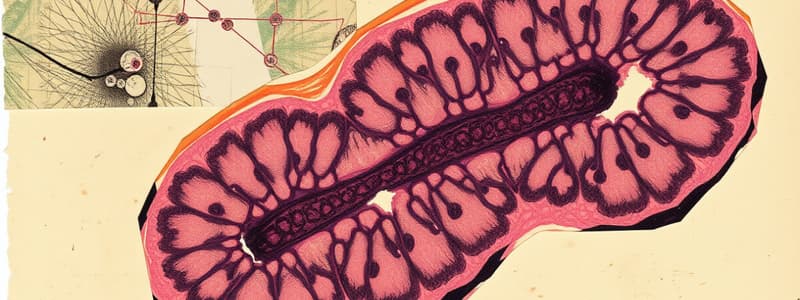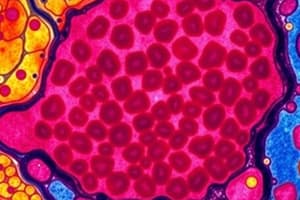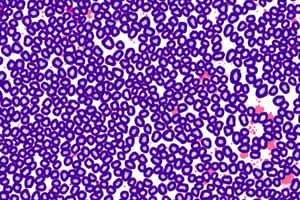Podcast
Questions and Answers
What is the primary role of extracellular fiber in connective tissue?
What is the primary role of extracellular fiber in connective tissue?
- Binds cells together
- Stores water
- Provides a medium for substance exchange
- All of the above (correct)
All supplements are beneficial for health.
All supplements are beneficial for health.
False (B)
What type of cells are fibroblasts and what is their primary characteristic?
What type of cells are fibroblasts and what is their primary characteristic?
Connective tissue cells; they are large and flat.
The main protein fiber found in connective tissue that provides strength is called ___ .
The main protein fiber found in connective tissue that provides strength is called ___ .
Match the descriptions with the correct types of connective tissue fibers:
Match the descriptions with the correct types of connective tissue fibers:
What is histology the study of?
What is histology the study of?
The four basic types of tissues include epithelial, muscular, connective, and neural.
The four basic types of tissues include epithelial, muscular, connective, and neural.
Name one type of cell junction.
Name one type of cell junction.
The epithelium that allows the body to interact with both its internal and external environments is called __________.
The epithelium that allows the body to interact with both its internal and external environments is called __________.
Match the type of epithelial tissue with its description:
Match the type of epithelial tissue with its description:
Which type of epithelial gland secretes hormones directly into the bloodstream?
Which type of epithelial gland secretes hormones directly into the bloodstream?
Connective tissue is primarily responsible for communication within the body.
Connective tissue is primarily responsible for communication within the body.
What main function do connective tissues serve?
What main function do connective tissues serve?
What type of fluid does the mesothelium secrete to help organs glide over one another?
What type of fluid does the mesothelium secrete to help organs glide over one another?
The composition of lymph is the same as that of blood plasma.
The composition of lymph is the same as that of blood plasma.
What type of membrane covers organs in body cavities that do not open to the exterior?
What type of membrane covers organs in body cavities that do not open to the exterior?
The epithelial layer of the synovial membrane contains ______ tissue.
The epithelial layer of the synovial membrane contains ______ tissue.
Match the following membranes with their functions:
Match the following membranes with their functions:
What is the main function of mesenchyme during the embryonic development?
What is the main function of mesenchyme during the embryonic development?
Loose connective tissue is primarily located only in the skin.
Loose connective tissue is primarily located only in the skin.
What type of loose connective tissue is found in the umbilical cord?
What type of loose connective tissue is found in the umbilical cord?
The _____ connective tissue is described as packing material and is the most widely distributed in the body.
The _____ connective tissue is described as packing material and is the most widely distributed in the body.
Match the loose connective tissue types with their descriptions:
Match the loose connective tissue types with their descriptions:
Which of the following connective tissues provides support in the umbilical cord?
Which of the following connective tissues provides support in the umbilical cord?
The primary function of loose connective tissue is to provide strength, elasticity, and support.
The primary function of loose connective tissue is to provide strength, elasticity, and support.
In which specific locations can areolar connective tissue be found?
In which specific locations can areolar connective tissue be found?
What is the primary function of cardiac muscle tissue?
What is the primary function of cardiac muscle tissue?
Cardiac muscle fibers are unique due to their branching structure.
Cardiac muscle fibers are unique due to their branching structure.
What are the finger-shaped projections that receive information from other neurons called?
What are the finger-shaped projections that receive information from other neurons called?
Cardiac muscle is surrounded by a thin layer of ___ and inner endocardium.
Cardiac muscle is surrounded by a thin layer of ___ and inner endocardium.
Match the part of the neuron with its function:
Match the part of the neuron with its function:
What structures help hold cardiac muscle cells together during vigorous contractions?
What structures help hold cardiac muscle cells together during vigorous contractions?
Gap junctions in cardiac muscle tissue are responsible for conductivity.
Gap junctions in cardiac muscle tissue are responsible for conductivity.
What type of muscle is responsible for involuntary movements in the heart?
What type of muscle is responsible for involuntary movements in the heart?
The long, tail-like projection that connects to the cell body of a neuron is called an ___.
The long, tail-like projection that connects to the cell body of a neuron is called an ___.
Which characteristic of cardiac muscle cells is visible and unique?
Which characteristic of cardiac muscle cells is visible and unique?
Flashcards are hidden until you start studying
Study Notes
Histo-logy Overview
- Histo- = tissue; -logy = study; histology studies tissues' structure and function.
Tissue Types
- Tissues are groups of similar origin cells that perform a common function.
- Four basic types of tissues aim to carry out specialized activities.
Epithelial Tissue
- Comprises surface epithelium and glandular epithelium; involved in protection, secretion, and absorption.
- Surface epithelium includes various styles:
- Simple squamous, cuboidal, nonciliated columnar, ciliated columnar, pseudostratified columnar, stratified squamous, stratified cuboidal, stratified columnar, and transitional.
- Glandular epithelium categorized into:
- Endocrine glands (hormonal secretion) and exocrine glands (secretion to surfaces).
Connective Tissue
- Functions include binding cells, storing water, medium for substance exchange, and protective roles.
- Components consist of:
- Extracellular fibers (e.g., collagen) and connective tissue cells (e.g., fibroblasts).
- Loose connective tissue types:
- Areolar: Packing material found almost throughout the body, offers strength and elasticity.
- Adipose: Stores fat, provides insulation and cushioning.
- Reticular: Provides supporting framework for organs and immune functions.
Membranes
- Various membranes include serous (lines body cavities) and synovial (lines joints).
- Serous membranes consist of mesothelium (simple squamous) and secrete serous fluid to reduce friction.
Nervous Tissue
- Composed of neurons and supporting cells.
- Neurons consist of:
- Cell body: Contains the nucleus; controls functions.
- Dendrites: Projections that receive information from other neurons.
- Axon: Long projection that transmits impulses from the neuron to other cells.
Key Concepts
- Cell junctions crucial for tissue function:
- Tight, adherens, desmosomes, hemidesmosomes, and gap junctions facilitate communication and structural integrity.
- Mesenchyme serves as the precursor for all connective tissues during early development.
- Connective tissues can vary in composition (e.g., lymph is liquid connective tissue with less protein than blood).
General Functionality
- Each tissue type plays a role in maintaining homeostasis, facilitating body function, and responding to environmental changes.
Studying That Suits You
Use AI to generate personalized quizzes and flashcards to suit your learning preferences.




